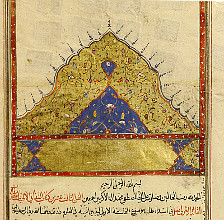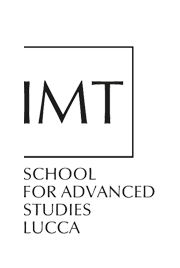State of the Art
Search of Manuscripts; Current Printings and Translations; Online Resources

Beginning of Ilāhiyyāt
Ms. Iran, Tehran, Kitābḫānah-i Millī Ǧumhūri-yi Islami-yi Iran (= National Library), 7590, ornamental detail
(S1) According to the available data, the Ilāhiyyāt is preserved, entirely or partially, alone or together with other parts of the Šifāʾ , in more than two hundred manuscripts throughout the world. Our actual knowledge of the manuscript diffusion of this work, however, is still partial and tentative, since the current bibliographies of Avicenna’s works are outdated (see the survey of the available bibliographical data in A. Bertolacci, “On the Manuscripts of the Ilāhiyyāt of Avicenna’s Kitāb al-Šifāʾ ”, in Islamic Thought in the Middle Ages. Studies in Text, Transmission and Translation, in Honour of Hans Daiber, ed. A. Akasoy, W. Raven, Brill, Leiden 2008, pp. 59-75, and the proceedings of the conference “The Manuscript Tradition of Avicenna’s Kitab al-Shifa’: The Current State of Research and Future Prospects”, Scuola Normale Superiore di Pisa, 22-24 September 2010, published as a special issue of the journal Oriens, 40.2, 2012). Also the study of the enormous indirect tradition of the work is still at its first steps: an international conference was expressly aimed at overviewing the influence of Avicenna’s metaphysics in later Arabic, Hebrew and Latin philosophy ("The Arabic, Hebrew and Latin Reception of Avicenna’s Metaphysics”, Villa Vigoni, Loveno di Menaggio (Co), Italy, 2-6 July 2008, org. D. N. Hasse, A. Bertolacci, proceedings published by De Gruyter, “Scientia Graeco-Arabica” 7, Berlin, 2012) .
(S2) All the existing printed versions rest on a fraction of this massive manuscript tradition. The integral printings of the Ilāhiyyāt are five. The first is the lithograph published in Tehran in 1885, encompassing, besides the Ilahiyyat, also the part of the Šifāʾ on natural philosophy: based on a group of manuscripts, whose number and identity is still to be ascertained, it reports interlinear or marginal corrections, and interlinear or marginal explanatory glosses by several commentators; it lacks, by its very nature, any critical apparatus. The still standard printed version of the Ilāhiyyāt, published in Cairo in 1960, is based on five manuscripts (with occasional recourse to a sixth), whose selection is limited not only in number, but also in geographical provenience (Cairo and London) and chronological range (the most ancient ms. date to the 13th century): though this edition encompasses a critical apparatus, it lacks a stemma codicum and a description of the editorial method. The printed versions of the Ilāhiyyāt published by Ḥ. al-Āmulī in Qum in 1997/8 (based on Iranian manuscripts), by E. Demirli and Ö. Türker in Istanbul in 2004 (repr. 2013), and by A. al-Sayāḥ and T. Wahba in Cairo in 2009, lack a critical apparatus. Attention to the indirect tradition of the work (glosses and commentaries) is paid only in the Tehran lithograph and in the partial edition of treatises I-II by Ḥ. Nāǧī Iṣfahānī (Tehran, 2004).
The results of a systematic comparison of the Cairo printed version of the Ilāhiyyāt with: (a) four ancient manuscripts not taken into account in it, some of which are about a century older than the oldest manuscripts employed in the Cairo printed version; (b) the other two printed versions of the Ilāhiyyāt currently available, namely the Tehran lithograph (more carefully inspected than in the Cairo edition) and the printed version by al-Amuli; (c) the Latin Medieval translation of this work, which – accomplished around the middle of the 12th century – is one of the most ancient witnesses of the text; (d) the metaphysical section of Avicenna’s Kitāb al-Naǧāt (Book of the Salvation), in which many passages of the Ilāhiyyāt are reproduced verbatim, are available in A. Bertolacci, “Towards a Critical Edition of the Ilahiyyat: List of Corrections of the Cairo Printed Text”, in Id., The Reception of Aristotle’s Metaphysics in Avicenna’s Kitab al-Šifāʾ, Brill, Leiden 2006, pp. 483-485. Likewise, a more focused investigation of key passages or parts of the work, based on the scrutiny of a larger sample of manuscripts, allows a more precise assessment of the historical background of the Ilahiyyat (see Id., “A Hidden Hapax Legomenon in Avicenna’s Metaphysics: Considerations on the Use of Anniyya and Ayyiyya in the Ilāhiyyāt of the Kitāb al-Šifā’”, in The Letter Before the Spirit. The Importance of Text Editions for the Study of the Reception of Aristotle, ed. A. M. I. van Oppenraay, with the collaboration of R. Fontaine, Brill, Leiden-Boston, 2012, pp. 289-309), and an appreciation of the different configurations that the work assumes in the manuscript tradition, as well as a glimpse of the Arabic background of the Latin translation (“How Many Recensions of Avicenna’s Kitāb al-Šifāʾ?” in Oriens, 40.2, 2012, pp. 275-303).
The existing translations of the Ilāhiyyāt into European languages are either based directly on manuscripts but obsolete (M. Horten’s German translation, 1904), or rest on the faulty Cairo printed text (G. C. Anawati’s French translation), with systematic comparison with other printings (O. Lizzini’s Italian translation), or personal emendations by the translator (M. E. Marmura’s English translation). The Italian translation prepared by the coordinator of the present project (Libro della Guarigione, Le Cose Divine di Avicenna (Ibn Sīnā), a cura di A. Bertolacci, UTET, Turin 2007, 856 pp.) is based on the textual revision mentioned above, and adopts a systematic articulation of the translated text, with explanatory paragraph-titles.
In all the aforementioned printed versions, the lexica – if available – are rudimentary. The Lexica in the critical edition of the Latin translation of the Ilāhiyyāt encompass only the parts of the Arabic original that were actually translated into Latin, and omit therefore some words or phrases of the Arabic text unavailable to, or omitted by, the Latin translator.
(S3) The existing websites on Arabic and Islamic philosophy include Avicenna among other prime philosophers and theologians (see, for example, “Islamic Philosophy Online”: http://www.muslimphilosophy.com). Likewise, websites of codicological interest regard transversally either single collections or libraries, or entire periods of the history of Arabic and Islamic philosophy. In the same vein, the most updated and detailed bibliographies of Islamic philosophy are wide-ranging overviews (see, for instance, http://philosophy.cua.edu/faculty/tad/bibliography-12-13.cfm, and previous installments). A website expressly and exclusively devoted to Avicenna, according to a codicological, ecdotic and bibliographical perspective, is still a desideratum.
Philosophy on the Border of Civilizations and Intellectual Endeavours:
Towards a Critical Edition of the Metaphysics (Ilâhiyyât of Kitâb al-Šifâʾ) of Avicenna (Ibn Sînâ)
ERC Advanced Grant 339621
Scuola Normale Superiore, Pisa, Italy
Piazza dei Cavalieri, n. 7
IMT School for Advanced Studies, Lucca, Italy
Piazza S. Ponziano, n. 6
Mail: info@avicennaproject.eu



